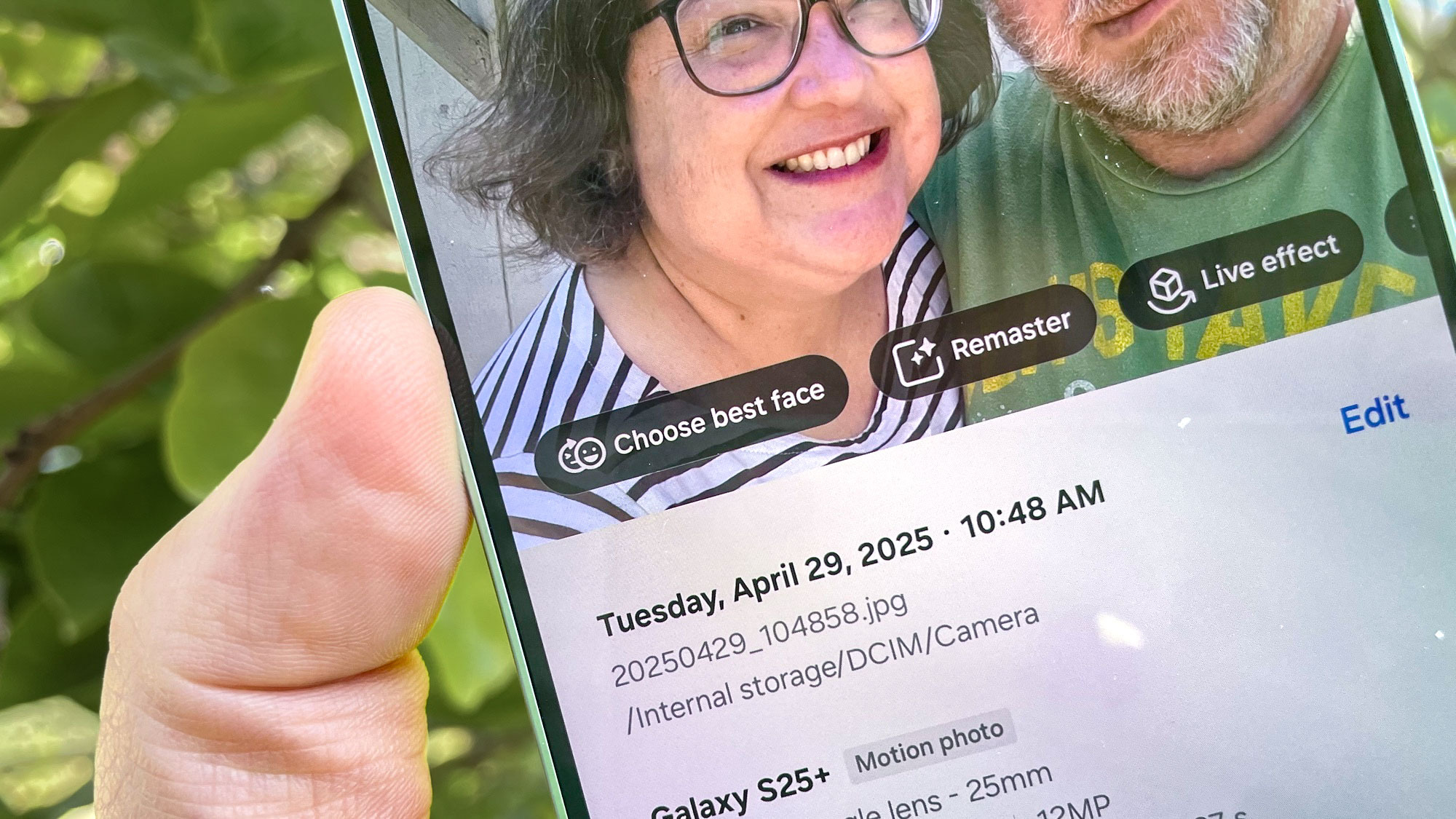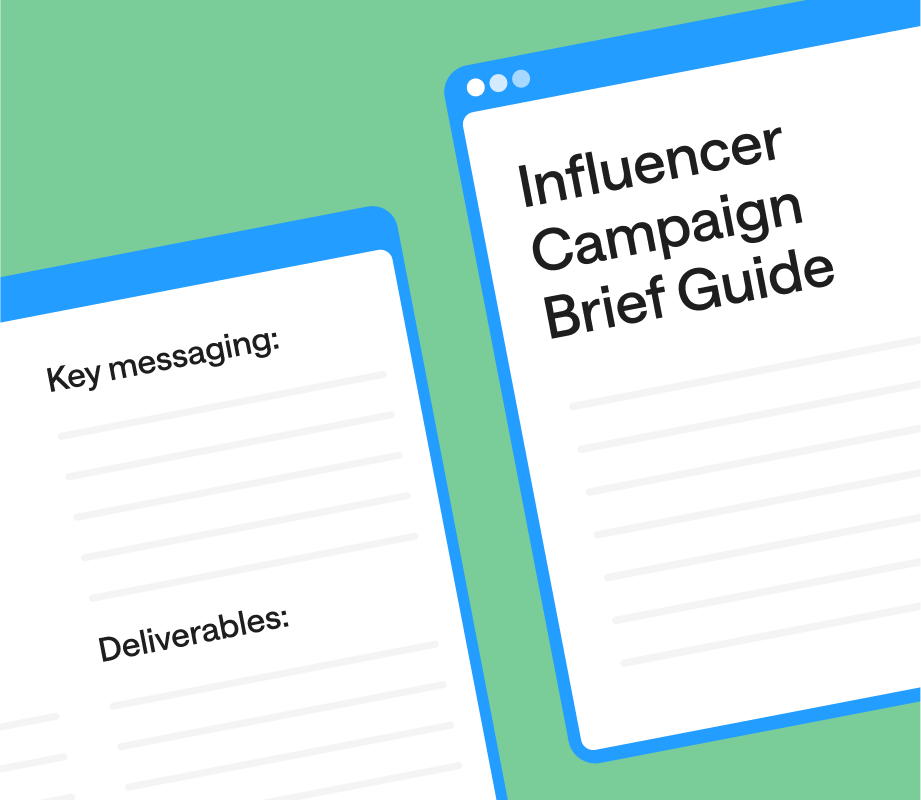Thinking of starting an employee advocacy program? Smart move. You could instantly gain hundreds of influencers who are motivated to extend your brand’s social reach through their ready-made social networks.
The question is, how will you manage it? I’ve done the whole share a link in Slack and hope people post it thing. There’s no oversight in the process or transparency in the outcomes.
I’ve also used and trialed several employee advocacy tools, and the difference is night and day. These applications help get more employees excited about sharing content and make it really easy for everyone involved. They also help you tie your advocacy program directly to business outcomes, which your leadership team will love.
Not all employee advocacy tools are the same. So, in this guide, I’ve reviewed eight popular options and organized them for the types of teams they’d work best for.
I’ve also asked two experts for tips on getting the most out of your employee advocacy tool. Kim Snow is the Head of Demand Generation at TeamOhana. And Laura Moss is an experienced Content Marketer who’s worked with a variety of large and small brands.
Best overall employee advocacy tool
This is a great place to start if you’re looking for a flexible, feature-filled employee advocacy tool that supports your overall social media marketing strategy and initiatives. Oh, and it doesn’t break the bank.
1. Hootsuite Amplify
Having spent some time encouraging team members to share company messages, I can confidently say that employee advocacy is all about collaboration. Hootsuite Amplify is the best in the biz at making it easy to collaborate with your entire team.
Amplify also has built-in approval processes and controls, which makes it super easy to make sure everyone follows your social media guidelines. And since it’s part of the Hootsuite social media management platform, you can boost and track all of your social engagement in one place.
.
Who is this for?
- Small to large businesses looking for a way to make employee advocacy easy, fun, and trackable.
- Teams that want to seamlessly fold an employee advocacy strategy into their larger social marketing plan.
Pricing: Amplify is included for Hootsuite Enterprise (custom pricing) customers.
SMM star rating: (5/5)
My favorite features:
- Slack and Microsoft Teams integrations: I love the integrations with MS Teams and Slack. An employee advocacy program only works if it’s easy for employees to do it. These integrations let people find and share content without leaving the communication platform they use every day.
- Amplify Leaderboard: The Leaderboard is so cool because it lets you gamify employee advocacy. You get to see your own shares, reach, and clicks. Then, you can also see a list of those metrics for other advocacy members. It really motivates a team to share more!
- AI content writer: Just like when you create a regular post, Hootsuite’s AI content writer will help you spin up post captions for advocacy content. I don’t use it to write from scratch, although you can. But I have used it to repurpose some of my top-performing social posts into something a team member can click and share — that saves a ton of time.
- A cohesive part of social media management: Amplify is part of Hootsuite, so managing employee advocacy feels more like a natural extension of social media management. You don’t have to use multiple tools, and you can get your advocacy metrics in the same place as your other social analytics. Plus, the Amplify mobile app lets user share on the fly.
What’s lacking/missing?
- A little picky, but it would be cool if you could set separate goals for individual users. That way, maybe newbies could have a lower “ramp-up” target, or a marketer could have a bigger goal than a product developer.
Customer review
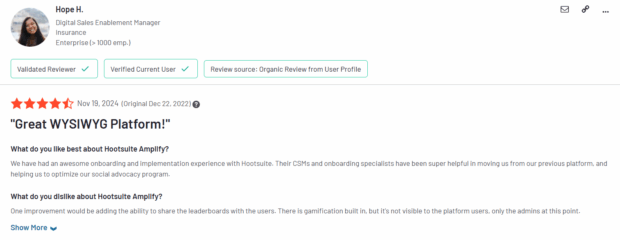
Source: G2
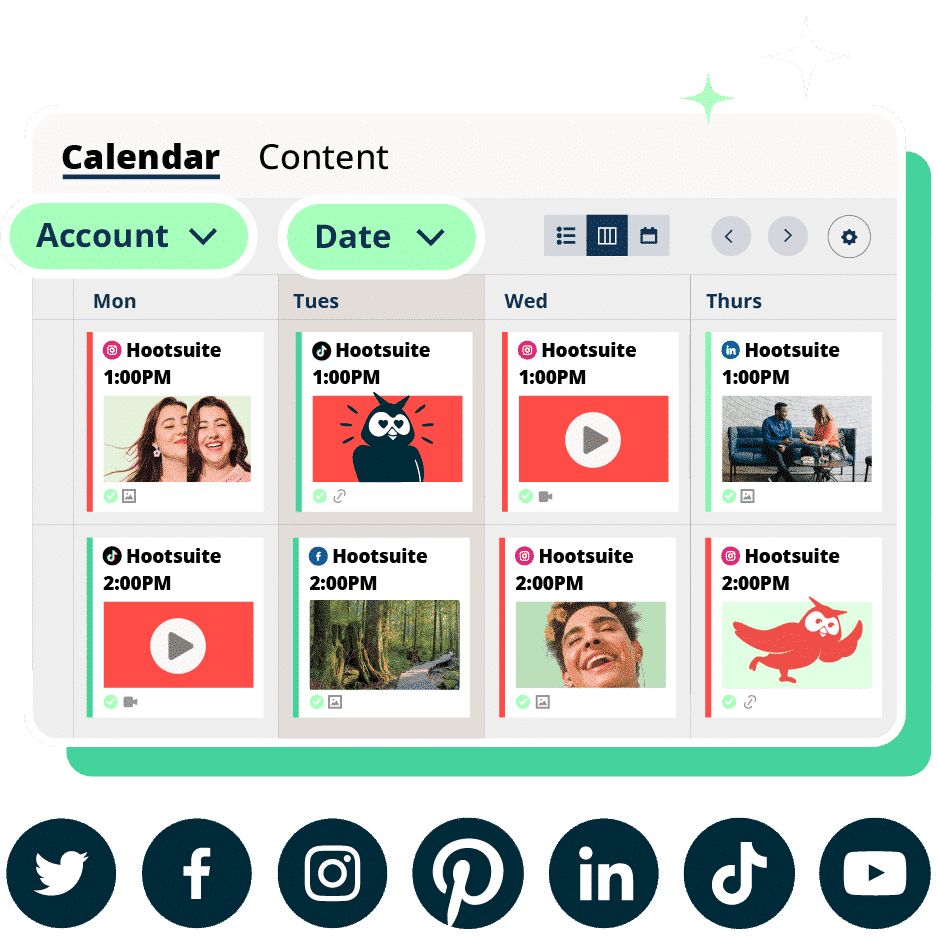
#1 Social Media Tool
Create. Schedule. Publish. Engage. Measure. Win.
Free 30-Day Trial
Employee advocacy platforms for large teams
Most employee advocacy tools fall into this category. They’re designed to coordinate large networks of advocates — and they come with a price tag to match. In fact, many don’t even post their prices publicly, you have to contact their sales team to ask (kinda like order the lobster at market price).
2. DSMN8
DSMN8 is one of the most full-featured, stand-alone employee advocacy platforms designed for large businesses. It has just about everything you could ask for when you’re managing a huge group of advocates — especially if they work in different geos and job functions.
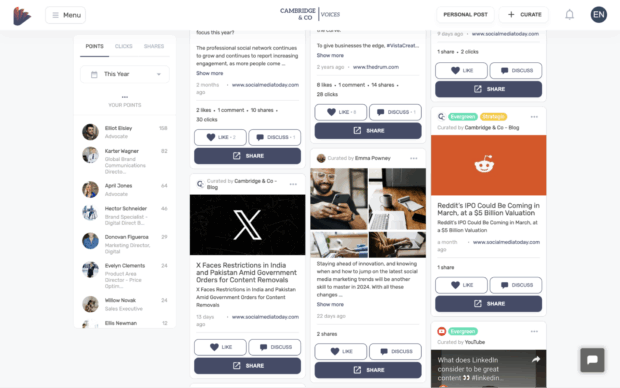
Source: DSMN8
Who is this for?
- Enterprise businesses with a large advocacy team (and budget) that need all the tools to manage it.
Pricing: Starting at $850/mo for the Start-up plan.
SMM star rating: (4.5/5)
My favorite features:
- User segmentation: If you have a large pool of employee advocates that span across several job functions, this feature is really handy. It lets you segment your advocates by geography and role so each gets relevant content for their employee networks.
- Content choices: You can create a variety of post captions, link titles, and preview images so your users can mix and match in their posts. That lets your team share unique content with just a few clicks that still honors the message.
- ROI tracking: There’s always a need to prove business results with an advocacy program, and DSMN8’s ROI tracking helps a lot here. It tells you the cost per click and earned media value for the attention your network’s posts get.
What’s lacking/missing?
- The price puts DSMN8 out of reach for many businesses that don’t have huge advocacy programs.
- Advocates can piece together unique posts, but they can’t customize them beyond that very much.
Customer review
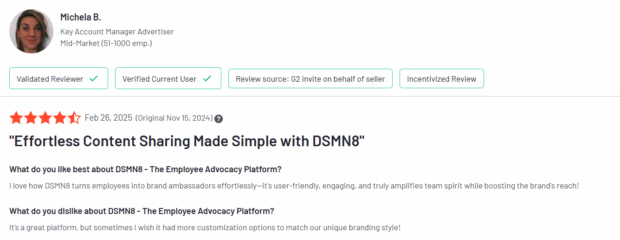
Source: G2
3. Sprinkler
Sprinkler offers basic but very usable advocacy features built into its marketing and customer success management platform. It doesn’t have some of the bells and whistles of other options on this list.
But I wanted to include it because it would be a good choice for brands that want fewer point solutions and the ability to incorporate advocacy into their CS and social management efforts.
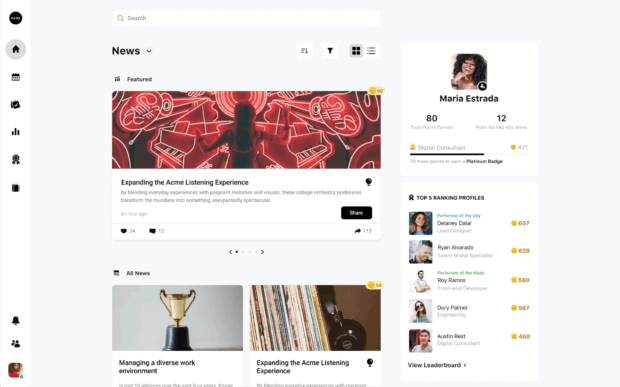
Source: Sprinklr
Who is this for?
- Businesses that want to simplify their tech stack by incorporating basic employee advocacy tools along with their CS management platform.
Pricing: Sprinklr doesn’t share pricing on its website, but a comparable plan to Hootsuite starts at $249 per month.
SMM star rating: (3.5/5)
My favorite features:
- Simplified approval workflow: Sprinkler’s content and advocate approval screens are simple and intuitive. You don’t have to hunt to see where you are in the content approval process, who’s involved, and what needs to happen next. You can even set up notifications to track how things are progressing.
- Awards and badges: I do really like that Sprinkler takes gamification one step further by awarding coins and badges for things like posts, likes, and comments.
- Salesforce integration: Sprinklr connects with Salesforce, which means you can synchronize the data from both platforms for a more unified view of customer management and your employee advocacy program.
What’s lacking/missing?
- Overall, Sprinklr is one of the more complex platforms on this list, so expect a bit of a learning curve once you get started.
Customer review:
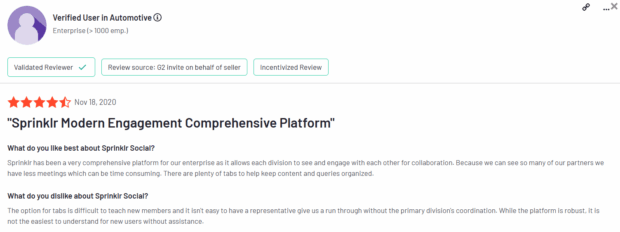
Source: G2
4. Haiilo
Haillo is an employee engagement platform that operates like an internal social media app. Employees can publish posts and then share, like, and comment on other employees’ posts. They can even join themed groups and connect peer-to-peer—it’s like Facebook for your business.
It landed on this list because the content posted on the company feed can be set up for sharing on external social media platforms — turning internal ideas into thought leadership content.
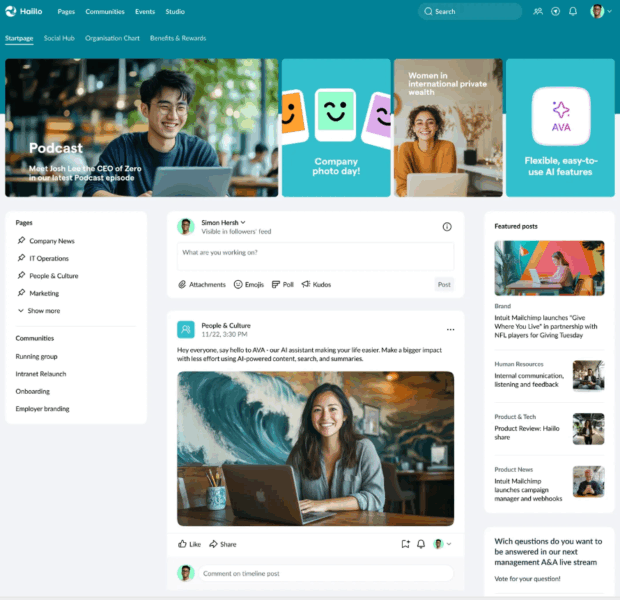
Source: Haiilo
Who’s this for?
- Haiilo relies on an active community of employees to generate and share content, so its best use case is large companies with big teams.
- Businesses that need an employee engagement tool and also want to launch an organized employee advocacy program.
Pricing: Haiilo pricing is based on custom quotes, so you’ll need to contact their sales team for a demo first.
SMM star rating: (4/5)
My favorite features:
- Intranet to external sharing ease: I’ve worked with several company communication platforms, but the social media-like interface on Haiilo is so much more engaging than most. For advocacy, it feels so natural to turn posts from internal thought leaders into one that employees can quickly share. I love that workflow.
- Peer-to-peer content ideation: The toughest part of social media marketing is constantly coming up with new ideas. The peer-to-peer nature of Haiilo means employees are always germinating the seeds of the next viral thought leadership LinkedIn post.
What’s lacking/missing:
- Haiilo gets nearly flawless marks as an internal communication tool, but compared to more comprehensive advocacy tools, it’s missing some features like AI post creation and ROI tracking.
Customer review:
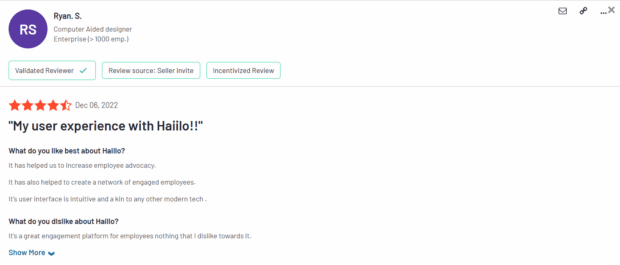
Source: G2
5. Sociabble
Sociabble is another internal communications platform that has some cool employee advocacy features added in. I like the emphasis Sociabble puts on employee-generated content (like UGC but for employees!) and social selling. Plus, the tool works really well with LinkedIn, so if that’s an important channel for your business, take a look at Sociabble.
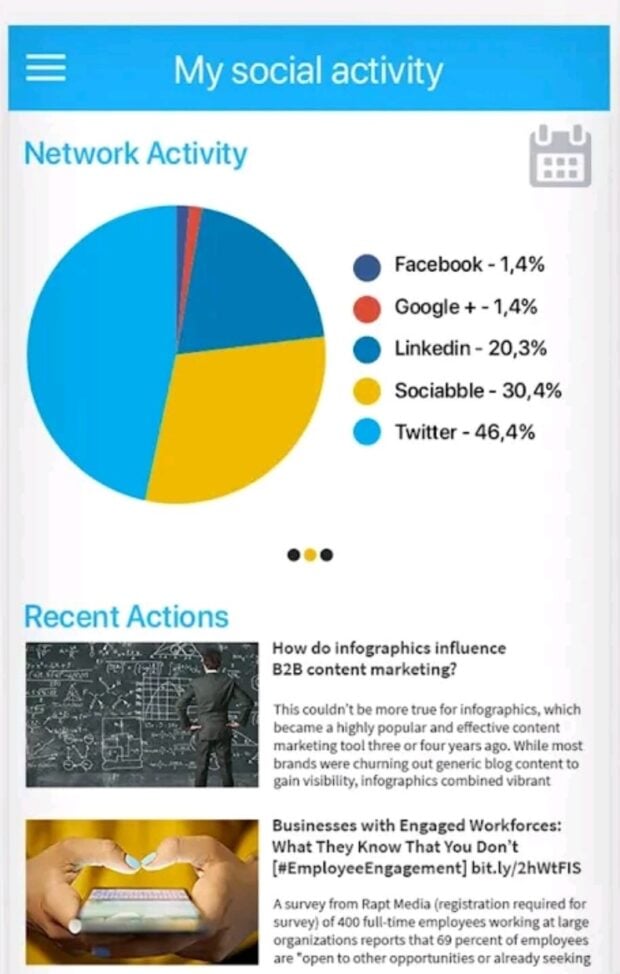
Source: Sociabble
Who is this for?
- Mostly large brands (Sociabble’s logo board includes Toshiba and Microsoft) that want to expand their social selling success on LinkedIn
- Businesses that need an enterprise-level employee communication platform and advocacy tools.
Pricing: Sociabble doesn’t have a pricing or package landing page, so you’ll need to contact them for a custom quote.
SMM star rating: (3.5/5)
My favorite features:
- Contextual content generation: Sociabble’s AI content generator takes a bunch of factors into account when creating social media captions. It’ll consider the context, user profiles, compliance guidelines, and your brand tone. So if I’m managing a lot of advocacy efforts with hundreds of participants, I don’t have to micro-manage what they share if they use Sociabble’s AI to write it.
- LinkedIn partnership: Socciabble’s LinkedIn API and partnership make it one of the best advocacy options for B2B businesses. For example, you can post and engage with LI content directly on the Sociabble app.
- Lead generation tracking: Like I mentioned, Sociabble is great for social selling. That carries through in its analytics, where you can track leads generated from your advocacy program. You can even use UTM tags to see which of your brand ambassadors is the lead-gen champion!
What’s lacking/missing?
- LinkedIn account tagging: There doesn’t seem to be a way to tag personal or business LinkedIn accounts on posts you create in Sociabble.
Customer review:
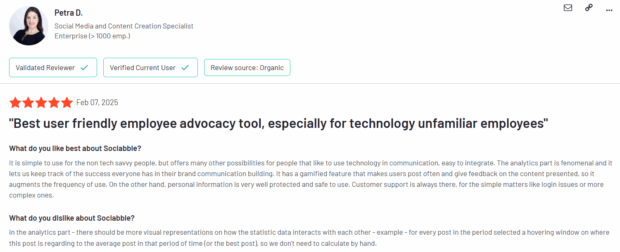
Source: G2
Employee advocacy tool for small teams
Growing teams need advocacy, too! These stand-alone employee advocacy tools won’t completely stress smaller marketing budgets (even if they aren’t exactly “cheap”).
6. Clearview Social
Clearview Social has an entry plan that comes in at about half the price of other dedicated employee advocacy software. Hootsuite’s social media management plans with advocacy tools are still less expensive, but if you want a stand-alone advocacy platform to compete with the big guys, I’d give Clearview a look.
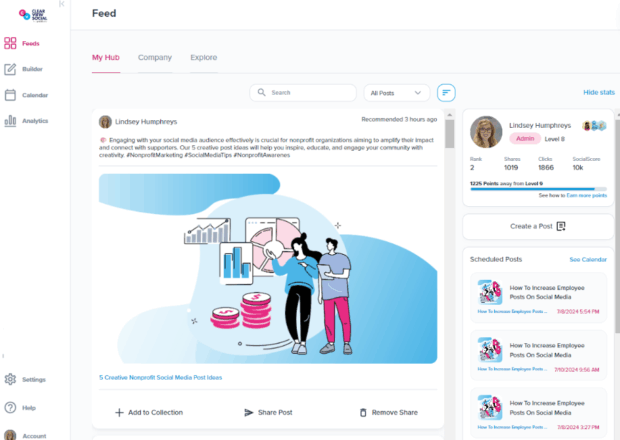
Source: Clearview Social
Who’s this for?
- Smaller businesses with fewer than 50 employee advocates will find Clearview more accessible than some of the more expensive options on this list.
Pricing: Plans start at $425 per month for one admin, three social accounts, and up to 50 employee advocates.
SMM star rating: (4/5)
My favorite features:
- Content discovery options: Clearview gives you several ways to curate content for your team to share. There’s a Chrome extension that allows users to grab what they like from the web. Integrated Google Alerts and RSS feeds continually send new content your way. And there’s a suggested content feature your employees can use to suggest content to the marketing team.
- Earned Media Value metric: I’ve struggled to quantify the effects of PR and brand awareness in the past. That’s why this platform’s Earned Media Value (EMV) metric jumped out at me. EMV calculates what it would cost to get the same amount of social media reach as your employee advocacy posts. That’s a quantifiable benefit you can include in monthly reports.
What’s lacking/missing:
- This isn’t relegated to just Clearview Social, but I really wish it let you tag people and businesses in content you publish from the platform.
Customer review:
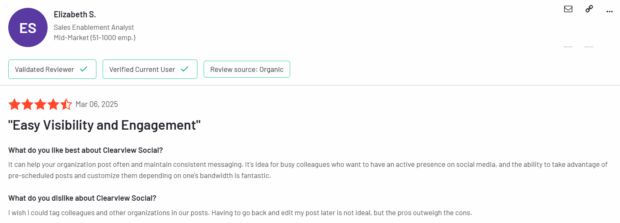
Source: G2
7. SocialToaster
SocialToaster is another employee advocacy platform with a pricing tier that’ll be more palatable for smaller teams. It includes similar standard features I’ve seen in other advocacy tools. I added SocialToaster to this list because it has a particular focus on gamification and rewards, which makes it an interesting choice for teams who want to ramp advocacy adoption in a hurry.
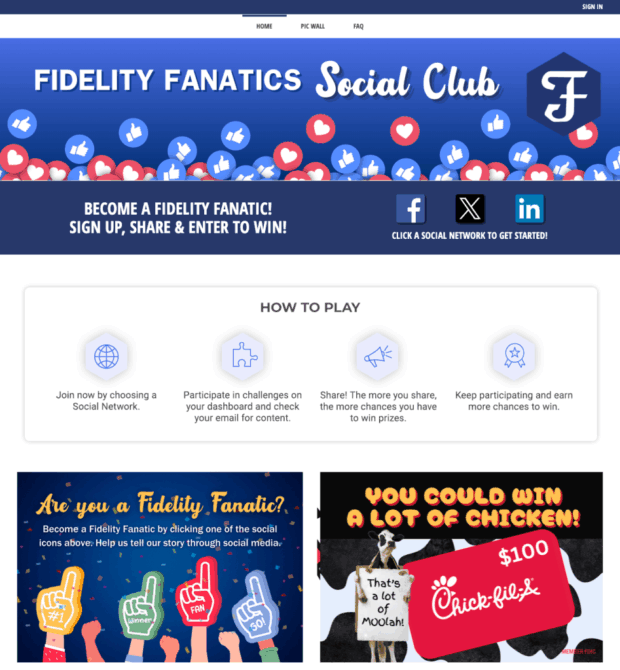
Source: SocialToaster
Who’s this for?
- Smaller brands that want to get into the advocacy game.
- Any sized business that wants to use incentives to get lots of internal (and even external) influencers sharing their content.
Pricing: The Bronze tier costs $450 per month and lets you have three admins and 200 users.
SMM star rating: (3/5)
My favorite features:
- ContentToaster: This is one of the best uses of AI I’ve seen in this category. Essentially, ContentToaster is an AI content curator. It continually reviews your digital assets (blog posts, white papers, etc.) and your advocates’ engagement. Then, it automatically sends content to each employer brand advocate that they’re more likely to engage with and share. So smart!
- Advocate rewards: Most advocacy platforms have some type of gamification feature. What’s interesting here is how SocialToaster lets you add and promote actual rewards (prizes, VIP experiences, etc.). That’ll motivate more employees to get involved. It also makes it possible to create a brand fan advocacy program where you incentivize customers to join and share your brand content.
What’s lacking/missing:
- You don’t get the same level of scheduling features on SocialToaster as you do on other platforms.
Customer review:
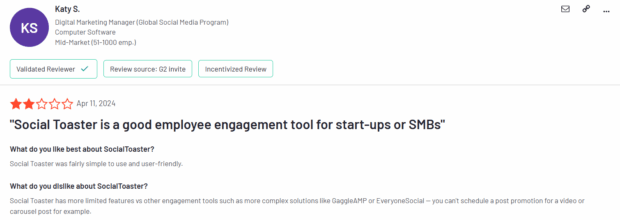
Source: G2
Employee advocacy tool for agencies
There aren’t any employee advocacy tools geared solely toward marketing agencies. But some do have features, like white-label reporting, that make them a fit for reselling an advocacy program.
8. GaggleAMP
GaggleAMP is also a stand-alone employee advocacy platform with all the typical features like one-click sharing and analytics. It stands out by offering tools that help each employee create unique — but on-brand — content and because it’s one of the easiest tools to learn and use.
I could have placed this tool in the “Large teams” group since GaggleAMP is designed for individual brand use. But it also has some interesting managed services training and features that help agencies offer it as a product to their clients.
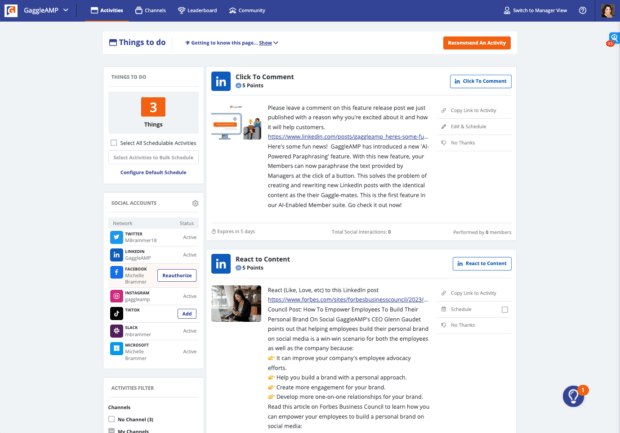
Source: GaggleAMP on LinkedIn
Who’s this for:
- Agencies looking to add employee advocacy as a sellable line item.
- Marketing teams who want a diverse set of voices sharing a singular brand message.
Pricing: GaggleAMP pricing starts at $8,800 per year for up to 100 members.
SMM star rating: (4/5)
My favorite features:
- AI-powered Paraphrase: Gaggle’s Paraphrase feature lets each employee reword a personalized version of a caption based on a core brand message. Not every employee is a social media Shakespeare, but you don’t want every post to look exactly the same. Paraphrase helps advocates write a unique post while staying on brand.
- Agency certification: GaggleAMP has a whole training and certification program for agencies. You’ll learn how to launch and run an advocacy program, how to package it with other services, and get some sales messaging to help you sell it.
What’s lacking/missing:
- GaggleAmp is easy to use, but there’s a lot to it, which can feel overwhelming at first.
- It would be cool if employees could get multiple AI post options to choose from.
Customer review:
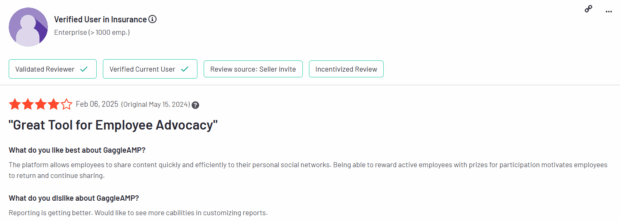
Source: G2
4 tips from the pros: How to optimize employee advocacy tools for better engagement
All of these tools nail the basic features needed to run a stellar employee advocacy program. The trick is how you use them. I asked a couple of experienced pros to give up their best secrets to get more employees hyped to be active ambassadors of your brand.
1. Explain the “why” behind employee advocacy
Your finance and product teams aren’t sitting around thinking about brand awareness and content reach. But their networks on LinkedIn and Facebook would be perfect for your message. Give them a little context into how their advocacy helps them and the organization.
“Many employees, especially those outside of sales or marketing, may not immediately see the value of engaging with company content on social media,” Snow shares.
“It’s essential to clearly communicate how even simple actions such as a like, comment, or reshare can significantly expand the reach and visibility of the company’s message,” she adds, “When employees understand the tangible impact of their engagement, they are more likely to feel motivated and invested in contributing.”
This is where all of those gamification and ROI reporting features come in handy. Don’t just report those numbers; report them laterally to other team members. Show them the real value of posting an article on their LinkedIn feed.
2. Remove friction from the process
Want your advocacy program to really take off? Avoid complexity.
“Make it as easy as possible for employees to participate,” Snow says. “Share direct links to the posts you want them to engage with, clearly outline what action you’re requesting (e.g., like, comment, or share), and provide a suggested timeframe for completion.”
Most employee advocacy tools offer one-click publishing and scheduling to help. Leverage those features and think of other ways to make sharing content super simple.
“By removing guesswork and minimizing effort, you increase the likelihood of consistent engagement,” Snow says.
3. Secure executive buy-in
Moss says that employee advocacy success starts at the top. “Get leadership involved,” she explains. “Your C-suite should be active on social for a variety of reasons (they have a built-in following, they’re the face of the company, etc.), but they also set an example for the rest of the company.”
Snow agrees. “Secure executive support early on and ask them to help reinforce engagement efforts with their teams,” she says. “It’s far easier to encourage peer participation when it’s modeled from the top.”
Most leaders want to understand the impact of a program before they support it. Start your pitch with the expected results, back it up with examples, and then lay out how it’ll work.
4. Identify existing advocates
You don’t need to start from scratch. It’s likely that some of your employees are already talking about your business.
“According to Weber Shandwick, 50% of employees who use social media are already posting about their companies there,” Moss points out. “Find these people, whether they’re in marketing or engineering, and empower them to lead the way for the rest of your employees.”
One good way to start is to check the activity on your brand’s LinkedIn account. Scroll through the reposts and company mentions to find employee posts. This is also a great time to fire up your social listening tools. Make note of brand and product mentions from employees, then reach out to help them operationalize their advocacy. And, of course, celebrate it with the team to get more people excited about joining.
Save time managing your social media presence with Hootsuite. Publish and schedule posts, find relevant conversions, engage your audience, measure results, and more — all from one dashboard. Try it free today.






